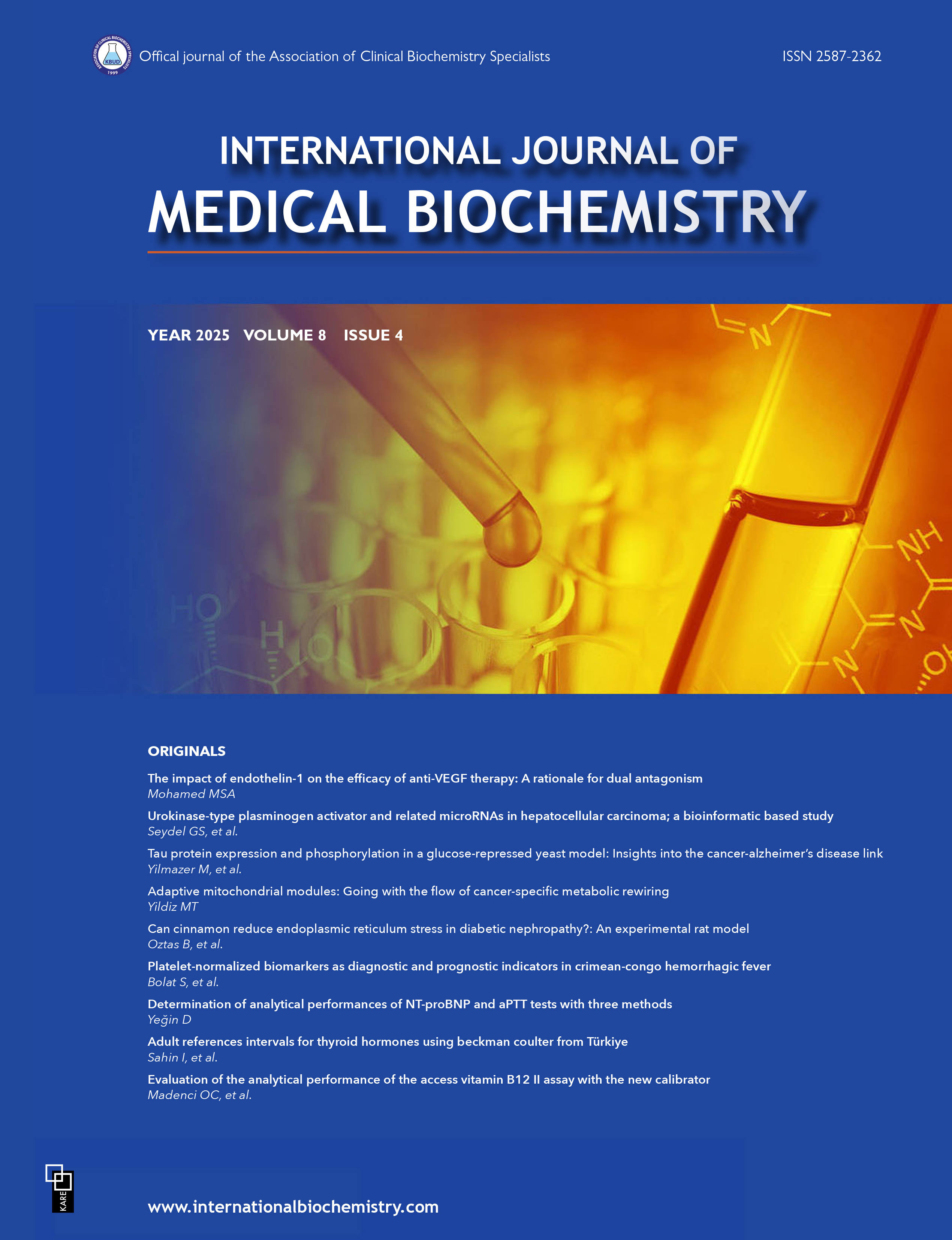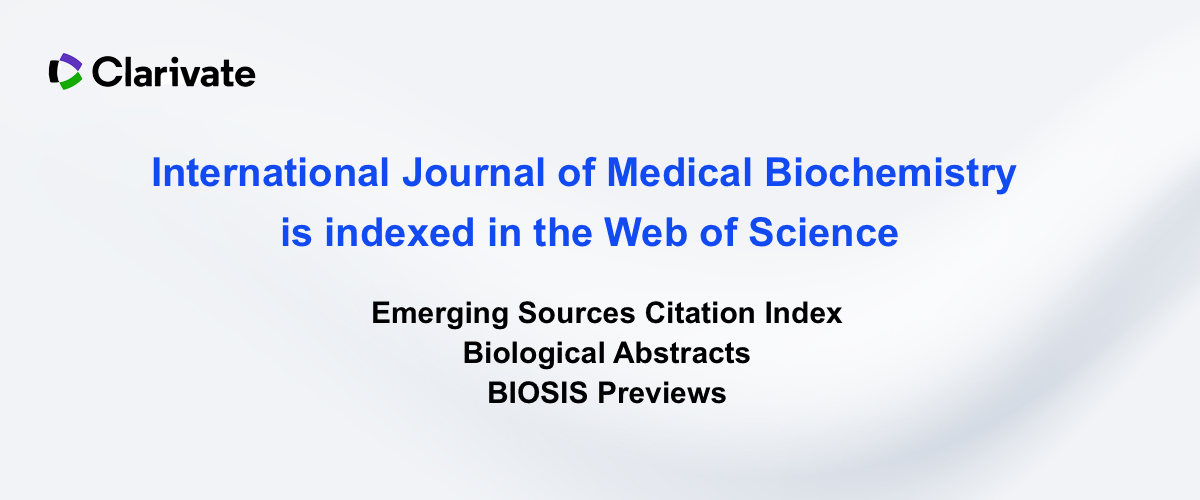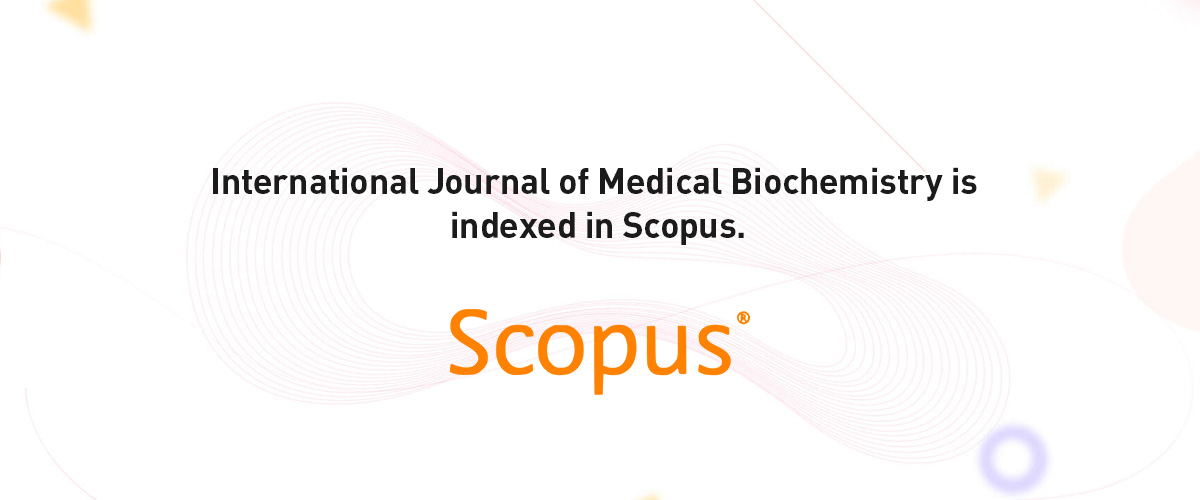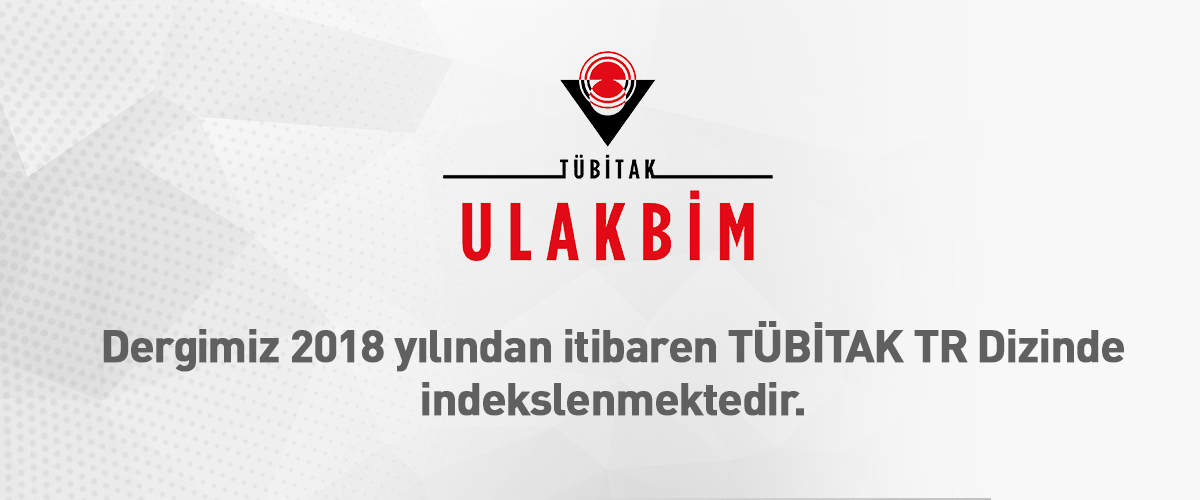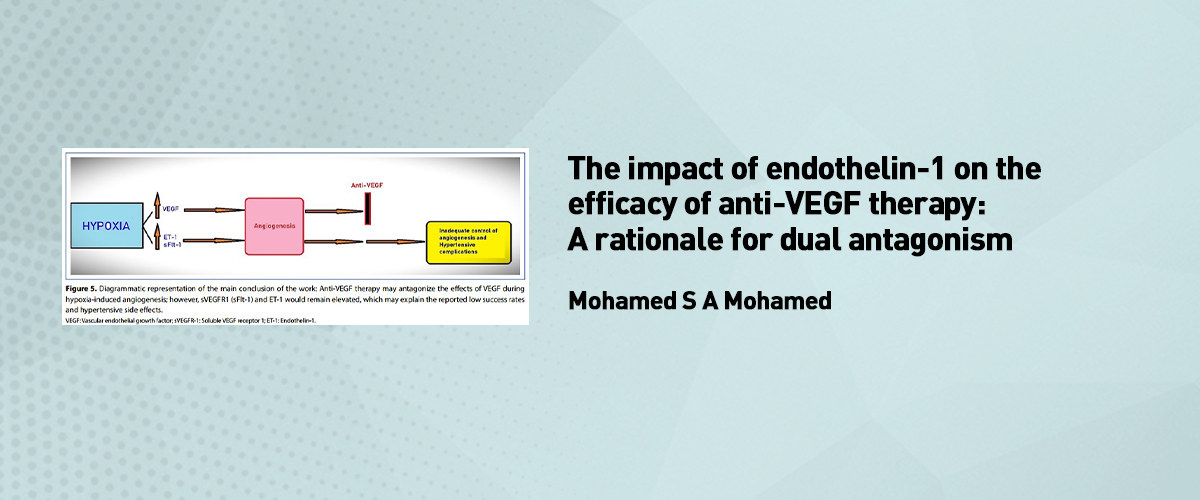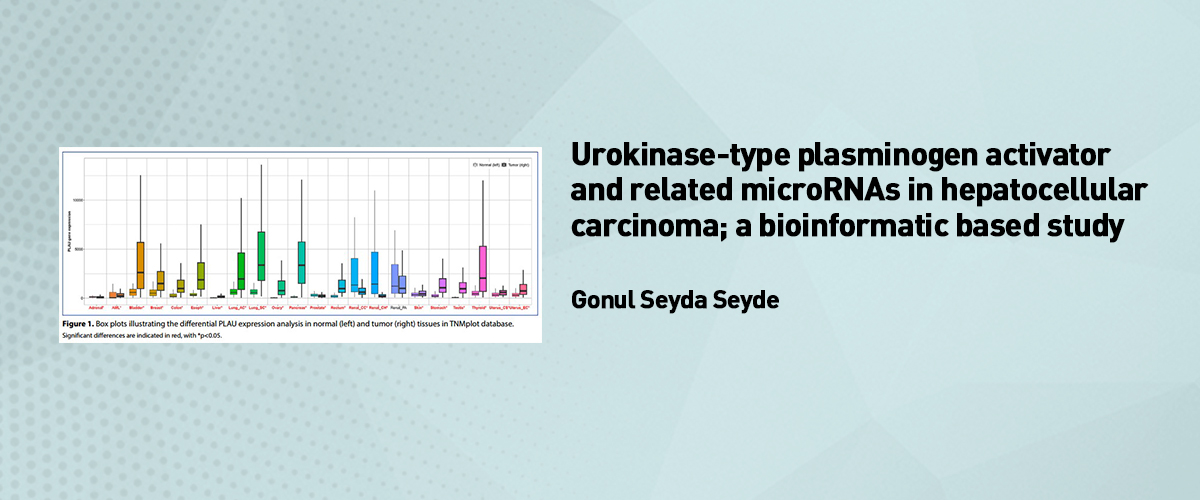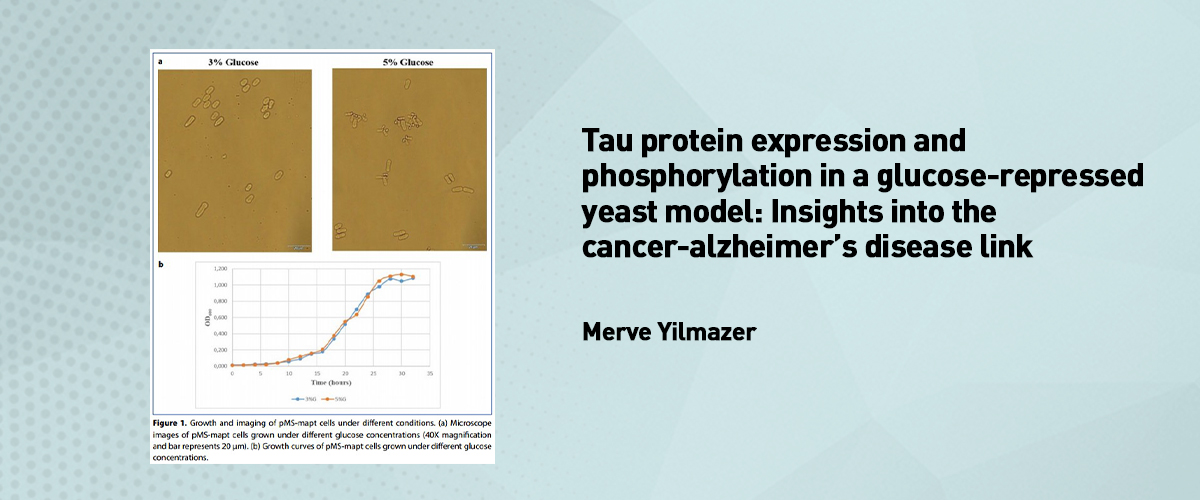Instructions For Authors
Aims & Scope
International Journal of Medical Biochemistry publishes articles relating to clinical chemistry, molecular biology and genetics, therapeutic drug monitoring and toxicology, hematology, immunology and laboratory medicine with the focus on analytical and clinical investigation of laboratory tests used for diagnosis, prognosis, treatment and therapy, and monitoring of disease. The official language of the Journal is English. The journal will be published 4 times a year in print and electronically.
Main Topics
- Clinical Biochemistry
- Molecular Biology
- Clinical Haematology
- Clinical Immunology
- Drug Monitoring and Analysis
- Diagnostic Biomarkers
- Disease-Oriented Topics (Cardiovascular Disease, Cancers, Diabetes, Obesity, Genetic Disorders, Neurodegenerative Disease e.g..)
- Pediatric Biochemistry
- Inherited Metabolic Disorders
- Newborn Screening: Congenital and Genetic Disorders
- New Reagents, Instrumentation, Technologies and Methodologies
- Laboratory Medicine; Quality, Safety, translational laboratory
- Clinical Metrology
International Journal of Medical Biochemistry is published in accordance with the principles of independent, unbiased, and double-blind peer review. Research articles, review articles, short communications, case-reports, opinion papers, letter to editor, technical notes, editorials and article-commentaries that have not been published elsewhere, are published in the journal. Four issues are released every year in January, April, July, and October.
The journal evaluates only the manuscripts submitted through its online submission system on the web site http://www.internationalbiochemistry.com Manuscripts sent by other means will not be accepted.
The primary conditions for the acceptance of manuscripts for publication are originality, scientific value and citation potential.
The manuscripts should be prepared in accordance with ICMJE Recommendations for the Conduct, Reporting, Editing, and Publication of Scholarly Work in Medical Journals (updated in May 2022 - https://www.icmje.org/recommendations/).
Authors are required to prepare manuscripts in accordance with the international guidelines* below.
Randomized Controlled Trial ** |
CONSORT (Consolidated Standards of Reporting Trials) |
Non-Randomized Trial ** |
TREND (Transparent Reporting of Evaluations with Non-randomised Designs) |
Trial Protocol |
SPIRIT (Standard Protocol Items Recommendations for Interventional Trials) |
Observational Epidemiologic Studies (cohort, case-control, cross-sectional) |
STROBE (the STrengthening the Reporting of OBservational studies in Epidemiology) |
Systematic Reviews and Meta-Analyses |
PRISMA (the Preferred Reporting Items for Systematic Reviews and Meta-Analyses) |
Systematic Reviews and Meta-Analyses Protocol |
PRISMA-P (the Preferred Reporting Items for Systematic Reviews and Meta-Analyses - Protocol) |
Qualitative Research |
-SRQR (the Standards for Reporting Qualitative Research) |
Methodological Studies (Translating and Adapting Tests) |
ITC (International Test Commission) Guidelines for Translating and Adapting Tests |
Methodological Studies (Developing Tests) |
COSMIN (COnsensus based Standarts fort the selection of Health Measurement Instruments-Study Design for Patient-reported outcome measurement instruments) |
Case Report |
CARE (CAse REport) |
* Enhancing the QUAlity and Transparency of Health Research (equator network)
** The International Journal of Medical Biochemistry encourages the registration of all clinical trials (randomized and non-randomized) via ClinicalTrials.gov or one of the registries of the WHOs International Clinical Trials Registry Platform (ICTRP). The name of the trial registry and the registration number together should be provided at the end of the abstract.
Peer Review Process
International Journal of Medical Biochemistry utilizes a double-blind peer review process where both the identities of reviewers and authors are anonymous. The Editor-in-Chief is responsible for the editorial and scientific content of the journal and makes the final decision.
Submitted manuscripts that pass preliminary control are evaluated by Editor-in-Chief for their originality, methodology, the importance of the subject covered and compliance with the journal scope. For the manuscripts that are considered for publication an unbiased, double-blind peer-review process is initiated by associate editors. The manuscripts are sent to two or more independent peer reviewers who are expert in the field. The reviewers are asked to provide detailed, constructive comments that will help the editor to make a decision, and the authors to improve their manuscript. The requested changes are made by the authors using the online manuscript submission system. Associate editor sends the original manuscript, the revised manuscript and all the reviewers’ comments together with his recommendation to the Editor-in-Chief.
Editor-in-Chief reviews the manuscript and makes the final decision. He might accept the manuscript, reject the manuscript or request further revisions.
In case of manuscripts submitted by editors or by the editorial board members of the journal, the editorial board will invite an external, independent editor to manage the evaluation processes of these manuscripts. The reviewers are required to notify the editor of any kinds of conflicts of interest with respect to the research, the authors and/or the research funders. They must ensure that all the information related to submitted manuscripts is kept as confidential and must report to the Editor-in-Chief if they are aware of copyright infringement and plagiarism on the author’s side.
International Journal of Medical Biochemistry takes into consideration the Committee on Publication Ethics - COPE guidelines and flow charts for peer review process.
Publishing Fee
International Journal of Medical Biochemistry is an open access journal. Manuscripts are available on the journal web page at no cost.
As of March 1, 2025, in order to further improve the quality and accessibility of the journal, a fee will be charged as a contribution to the cost of production. This fee will be charged during the process of application of submitted articles and will be charged regardless of eventual acceptance/rejection of the manuscript.
NO PUBLICATION FEE (Article Processing Charge) is charged for articles submitted by AUTHORS FROM TURKIYE. Foreign authors can complete the article submission process after depositing to the USD account below.
Research Article - USD 1000.- (VAT included)
Systematic reviews and meta-analyses/Review - 1000.- (VAT included)
Case Report/Technical Note/Letter/Opinion - USD 700.- (VAT included)
Account Holder: KARE MEDYA LIMITED SIRKETI
Account Number: 26297654
IBAN: TR71 0006 7010 0000 0026 2976 54
SWIFT CODE: YAPITRISXXX
Address: Sahrayicedit, Ataturk Cad. No: 43A, Kadikoy, Istanbul, Turkiye
Preparation and Submission of Manuscripts
Manuscript files should be prepared with Microsoft Office Word. The online submission system will direct authors during all stages of submission and provide necessary support for accelerating the submission process. A list of the files that should be supplied through the online submission system is provided below.
- Title Page
- Main Text
- Tables, Graphs and Figures
- Copyright Transfer Form
- Author Contribution Form
ICMJE Uniform Disclosure Form for Potential Conflicts of Interest
Manuscript Types
Contributions may be in the form of clinical and basic Original Research articles, Reviews, Short communications, Case reports, Letters to the Editor, Opinion papers, Technical notes and Editorial Comment. The Journal also publishes brief reports on original studies or evaluations, book reviews, and proceedings of scientific meetings.
- Original Research
Consists of Title, Authors, their addresses, Abstract, Key Words, Introduction, Materials and Methods, Results, Discussion, Ethical Considerations (if necessary), Acknowledgements, Conflict of Interest, References, Figure Legends, Figures, and Tables. It should not exceed 5000 words excluding the references. The manuscript should have no more than 50 references and a total of 6 tables and/or figures.
- Review
Reviews prepared by authors with extensive knowledge on a particular field, which has been reflected in international literature by a high number of publications and citations, are evaluated. The authors may be invited by the Editor-in-Chief. A review should be prepared in the format describing, discussing and evaluating the current level of knowledge or topic that is to be used in the clinical practice and it should guide further studies. A review article consists of Title, Authors, their addresses, Abstract, Key Words, Introduction, Main Sections under headings written in bold and sentence case, Subsections (if any) under headings written in italic and numbered consecutively with Arabic numerals, Conclusion, Acknowledgements, Conflict of Interest, References, Figure Legends, Figures, and Tables. The manuscript should have no more than 75 references and a total of 6 tables and/or figures. Supplemental data are permitted for Review articles. Abstract should not include subheadings and should be limited to 300 words. Keywords section should contain a minimum of three and a maximum of six items in accordance with Medical Subject Headings (MeSH) terms prepared by the National Library of Medicine (NLM) and should be provided just below the abstract. Main Text should include Introduction, other subheadings and Conclusion sections and should be limited to 5000 words excluding the references. Tables, Figures and Images should be provided after the reference list according to their order of appearance in the text.
NOTE: The originality of the visuals included in the reviews should be assured by submission of an accompanying letter by the authors. Appropriate citation should be done for the visuals adapted from previously published sources, in accordance with the original versions of the printed or electronic copies. The written permission obtained from the copyright holder (publisher, journal or authors) should be sent to the Editor-in-Chief’s Office.
- Short communications
These manuscripts are intended to concise and quick publishing of a new finding. Publishing of research articles under this concept is decided by the Editorial Board, providing that the authors adhere to the publishing format. The general format of this type of manuscript is similar to that of research articles except the word and reference limitations. For the short communications, main text should not exceed 1,500 words and number of references should not exceed 15.
- Case Report
Since a limited number of case reports is published, only reports which are related to rare cases and conditions that constitute challenges in diagnosis and treatment, offer new methods or suggest knowledge not included in books, and are interesting and educational are accepted for publication. A case presentation consists of Title, Authors, their addresses, Abstract, Key Words, Introduction, Patients and Methods, Results, Discussion, Conclusion, Ethical Considerations, Acknowledgements, Conflict of Interest, References, Figure Legends, Figures, and Tables. Main Text should not exceed 1500 words excluding the references. The reference list should follow the main text and the number of references should be limited to 15. Tables, Figures and Images should be provided after the reference list according to their order of appearance in the text and should be limited to two.
- Letter to the Editor
Letters to the Editor aim to discuss the importance of a manuscript previously published in the journal. This type of manuscripts should also include a comment on the published manuscript. Moreover, articles on topics of interest to readers within the scope of the journal, especially on educational issues, can be published in the format of a Letter to the Editor. It consists of title, main text and references sections. Abstract, Keywords, Tables, Figures and Images, and other visuals are not included. Main Text should not include subheadings and it should be limited to 500 words. The reference list should follow the main text and the number of references should be limited to five. The volume, year, issue, page numbers, authors’ names and title of the manuscript should be clearly stated, included in the list of references and cited within the text.
- Opinion papers
Opinions on the topics within the scope of the journal that are prepared by the experts are published in this section. An opinion consists of Title, Authors, their addresses, Abstract, Key Words, Introduction, Discussion, Conclusion, Ethical Considerations (if necessary), Acknowledgements, Conflict Of Interest, References, Figure Legends, Figures, and Tables. Editorial Board decides the eligibility of an opinion with respect to its concept and language. For the opinions, main text should not exceed 1,500 words and number of references should not exceed 15.
- Technical reports
Manuscripts on development and application of new methodologies are published in this category. A technical report consists of Title, Authors, their addresses, Abstract, Key Words, Introduction including the main aspects of the method involved, Materials and Methods, Results, Discussion, Ethical Considerations (if necessary), Acknowledgements, Conflict of Interest, References, Figure Legends, Figures, and Tables. Data analysis should be presented in Materials and Methods. Clinical technical reports should include and discuss the clinical significance of values and their deviations. For the technical reports, main text should not exceed 1,500 words and number of references should not exceed 10.
- Editorial Comment
Authors are selected and invited by the Editor-in-Chief. This type of manuscript aims at providing a brief commentary on an article published in the journal by a researcher who is an authority in the relevant field or by the reviewer of the article. It should consist of title, main text and references sections. Main Text should not include subheadings and should be limited to 500 words. The reference list should follow the main text and the number of references should be limited by 15. Abstract, Keywords, Tables, Figures, Images and other visuals are not included in editorial comments.
Preparation of Manuscripts
Manuscripts should be prepared according to the above mentioned word and reference limitations and other related information. Language: Manuscripts should be written in clear and concise English. Please have your text proofread by a native English speaker before you submit for consideration.
The manuscripts submitted to our journal are classified and evaluated according to the manuscript types stated below. During preliminary evaluation, the editors assess whether a manuscript’s format and sub-headings are prepared in accordance with the journal’s guidelines. Therefore, it is important that authors check the accuracy of the main text in terms of the following.
Title Page
Title should be concise and informative and reflect the content of the manuscript and should not exceed 15 words. Avoid abbreviations and formulae where possible. It should be written in sentence case; that is, first letter of the initial word should be written in capital letter and rest of the title should be typed with lower case letters except proper nouns and abbreviations.
Information about the authors and their institutions should not be included in the main text, tables and figures . Since submitted manuscripts are evaluated by the reviewers through the online system, personal identification is excluded in the interests of unbiased interpretation. Thus, only information about the manuscript as specified below should be included on the title page. For each type of manuscript, it is mandatory to upload a title page as a separate Microsoft Word document through the online submission system. The title page should include the names of the authors with their latest academic degrees, and the name of the department and institution, city and country where the study was conducted. If the study was conducted in several institutions, the affiliation of each author must be specified with symbols. The first
letters of authors’ names and surnames should begin with capital letter and the rest should be written in lower case letters. If there is more than one author, corresponding author should be indicated.
The correspondence address should contain the full name of the corresponding author, postal and e-mail addresses, phone and fax numbers. If the content of the manuscript has been presented before, the name, date and place of the meeting must be noted. Disclosure of conflict of interest, institutional and financial support, author contributions and acknowledgments should be included on the title page.
Structured Abstract
It should be structured with Objective, Methods, Results and Conclusion subheadings and should be limited to 300 words. The abstract should state briefly the purpose of the research, the principal results and major conclusions. An abstract is often presented separately from the article, so it must be able to stand alone. For this reason, References should be avoided. Also, non-standard or uncommon abbreviations should be avoided, but if essential they must be defined at their first mention in the abstract itself. Level of evidence has to be stated at the end of the abstract as a separate paragraph.
Keywords
This section should contain a minimum of three and a maximum of six items in accordance with Medical Subject Headings (MeSH) terms prepared by the National Library of Medicine (NLM) and should be placed just below the abstract.
Main Text
Text should be prepared with MS Word document. All text should be written with Arial font type at 12 font size and double spaced on A4 sized paper with 1 cm right margin and 3 cm other margins. Header and/or footer should not be inserted in the text except that the pages should be numbered with Arabic numerals. Main text should consist of title, introduction, materials and methods, results and discussion
Introduction: State the objectives of the work and provide an adequate background, avoiding a detailed literature survey or a summary of the results. The unnecessary details and excessive references should be avoided. Hypothesis and the aim of the study should be stated in the introduction.
Material and methods: Provide sufficient detail to allow the work to be reproduced. Methods already published should be indicated by a reference: only relevant modifications should be described. Design and place of the study, subjects/patients, if applicable, information on the treatment procedures, statistical methods and information on the adherence to the ethical rules should be indicated.
Statistical analysis should be conducted in accordance with the guidelines on reporting statistical data in medical journals. The software used for statistical analysis must be described. The outcomes of statistical analyses and interpretation of the results must be in evidence-based scientific language. Statistics- statistical methods should be explained in detail in the Materials and Methods so that if original data is given, the results can be verified. If possible, quantitative results should be given and appropriate indicators should be used to indicate measurement error or uncertainty.
Results: Results should be clear and concise. Results must be concise and include figures and tables. Descriptive statistics should be compatible with the nature of data and statistical analyses used. The graphs should be prepared to reflect the important features of data. Please avoid excessive figures and tables.
Tables, Graphs and Figures
- Tables, Graphs, Figures and other visuals should be numbered in the order of their citation within the text and names of patients, doctors and institutions should not be disclosed.
- Tables should be prepared in a Microsoft Office Word document using the command ‘Insert Table’ and inserted at the end of the references in the main text.
- Tables should not be submitted in JPEG, TIFF or other visual formats. For microscopic images, the magnification ratio and staining technique used should be specified in addition to figure legends.
- Roman numbers should be avoided in tables and figures within the text and their titles. Each table should be clearly labeled and numbered consecutively with Arabic numerals (Table 1, Table 2, etc.). The abbreviations used must be defined. As with the text, reporting of concentration units consists of analyte concentrations expressed in the text in the traditional mass unit (mg/dL, ng/ml, and so forth) followed by the SI unit in parentheses
- The thickness of the lines in graphs should be sufficient to minimize loss of quality if size reduction is needed during the printing process. The width of the graphs should be 9 cm or 18 cm. Drawings should be performed by professionals. No grey colours should be used.
- Abbreviations should be explained in alphabetical order at the bottom of the tables, graphs and figures.
- Explanations should be at the bottom of the table as footnotes.
- Tables should not be divided into parts. Separate parts (Table 1A, Table 1B, etc.) will be considered separate tables and will count toward your overall table/figure count.
- Table captions should be limited to 60 words.
- Tables should be easily understandable and should not repeat the data in the main text.
- In addition to the pictures included in case reports and original images, video and movie images are published on the journal’s website. These images should be prepared in MPEG format with a maximum size of 2 MB. They should be submitted to the journal with the manuscript documents. The names of patients, doctors, institutions and places should be omitted from all documents.
- All figures must be uploaded separately as image files in Tagged Image File Format (.TIFF) or Encapsulated Postscript (.EPS). Microsoft Power Point (.PPT) is also acceptable; however, the graphics must contain embedded fonts with one image per slide, one slide per file. Each image should have a resolution of 600 dots-per-inch (dpi).
- Indicate each footnote in a table with a superscript lowercase letter.
Discussion:This should explore the significance of the results of the work, not repeat them. A combined Results and Discussion section is often appropriate. Avoid extensive citations and discussion of published literature.
Conclusions:The main conclusions of the study may be presented in a short Conclusions section, which may stand alone or form a subsection of a Discussion or Results and Discussion section.
Appendices
If there is more than one appendix, they should be identified as A, B, etc. Formulae and equations in appendices should be given separate numbering: Eq. (A.1), Eq. (A.2), etc.; in a subsequent appendix, Eq. (B.1) and so on. Similarly for tables and figures: Table A.1; Fig. A.1, etc.
Abbreviations
Define abbreviations that are not standard in this field in a footnote to be placed on the first page of the article. Such abbreviations that are unavoidable in the abstract must be defined at their first mention there, as well as in the footnote. Ensure consistency of abbreviations throughout the article.
Acknowledgements
Collate acknowledgements in a separate section at the end of the article before the references and do not, therefore, include them on the title page, as a footnote to the title or otherwise. Financial and/or technical (running of tests, evaluation of results, providing language help, writing assistance or proof reading the article, etc.) supports of the study should be mentioned following Ethical Considerations including the project number. If the study originates from a thesis or has been previously presented in a meeting, this should also be indicated in this section. Contribution of each author should be declared in this section.
Nomenclature and units
Follow internationally accepted rules and conventions: use the international system of units (SI). If other quantities are mentioned, give their equivalent in SI. Authors wishing to present a table of nomenclature should do so on the second page of their manuscript. You are urged to consult IUB: Biochemical Nomenclature and Related Documents for further information.
Footnotes
It should be used sparingly. Number them consecutively throughout the article, using superscript Arabic numbers. Many word processors build footnotes into the text, and this feature may be used. Should this not be the case, indicate the position of footnotes in the text and present the footnotes themselves separately at the end of the article. Do not include footnotes in the Reference list.
Math formulae
Please submit math equations as editable text and not as images. Present simple formulae in line with normal text where possible and use the solidus (/) instead of a horizontal line for small fractional terms, e.g., X/Y. In principle, variables are to be presented in italics. Powers of e are often more conveniently denoted by exp. Number consecutively any equations that have to be displayed separately from the text (if referred to explicitly in the text).
Special Terms and Conditions
For double-blind peer-review process, the names of the corresponding author and other authors, their affiliations and any information on the study centres should not be included in any part of the submitted manuscripts and images, except the Title Page. This information should be added to the relevant section of the online submission system and included in the Title Page.
Pharmaceutical products should be written with their generic names and brand and company names, city and country should be specified for medical equipment and devices.
For centrifugation, angular velocity (xg) should be given. Period should be used to show decimals.
Enzymes: Full name of an enzyme and its International Union of Biochemistry and Molecular Biology (IUBMB) Enzyme Commission number (EC number) should be given when that enzyme was first mentioned in the text. Its abbreviation can be used after that. For detailed information, authors can refer to the Enzyme Nomenclature of IUBMB (www.chem.qmul.ac.uk/iubmb/enzyme). Enzyme activity should be given in terms of U/L in serum or plasma and U/mg protein in tissues. Unit (U) should be given as reaction rate triggered under defined conditions. SI unit for enzyme activity is defined as katal which is the moles of substrate converted to product per second. However, it can also be defined as µmol/sec or µmol/min as long as clear and precise definitions are given.
References
- References should start on a separate page. Published manuscripts and manuscripts that have been accepted and are pending publication should be cited in the reference list. Acceptance letter of the manuscripts that are pending publication should be submitted with the manuscript. Unpublished results should be written in text in parenthesis as “(unpublished result)’’. If such a work is cited, permission from the responsible researcher should be obtained and submitted with the manuscript.
- The reference list containing all authors mentioned in the text, should be arranged in the order of appearance and numbered accordingly by Arabic numerals in in square brackets in line with the text. When more than one reference is cited consecutively, not all of the reference numbers should be written separated by comas; instead the numbers of first and the last reference cited for that section should be written with a dash in the middle (i.e.: writing as “10, 11, 12, 13” is wrong, but “10- 13” is correct). Citation of a reference as 'in press' implies that the item has been accepted for publication.
- References that are inaccessible and not indexed in any database should not be cited.
- The actual authors can be referred to, but the reference number(s) must always be given. Example: '..... as demonstrated [7,8]. Dildar and Murat [9] obtained a different result ....'
- Authors’ names are inverted (last name, first/second initial). Do not add periods or commas within an individual author name; however, separate author names with a comma and end the author list with a period (Konukoglu D, Ilhan N, Orem A)
- The Journal names should be abbreviated as indicated at PubMed.
- For references with six and fewer authors, all authors should be listed. For references with more than six authors, the first six authors should be listed, followed by ‘et al’.
- Do not add a period after the journal abbreviation, but continue with a space followed by the year.
- The year should be followed by a semicolon and then the volume number, which is followed by a colon and then the page numbers. Delete redundant numbers, for example 2017;12:101-15.
- Do not include the months in parentheses; this information is not needed.
- Use inclusive page numbers for articles and book chapters.
Data References
This journal encourages you to cite underlying or relevant datasets in your manuscript by citing them in your text and including a data reference in your Reference List. Data references should include the following elements: author name(s), dataset title, data repository, version (where available), year, and global persistent identifier. Add [dataset] immediately before the reference so we can properly identify it as a data reference. The [dataset] identifier will not appear in your published article.
Web References
As a minimum, the full URL should be given and the date when the reference was last accessed. Any further information, if known (DOI, author names, dates, reference to a source publication, etc.), should also be given. Web references can be listed separately (e.g., after the reference list) under a different heading if desired, or can be included in the reference list.
References in a Special Issue
Please ensure that the words 'this issue' are added to any references in the list (and any citations in the text) to other articles in the same Special Issue. The style and punctuation of the references should be formatted as in the following examples.
Technical Reports
Surname(s) and initial(s) of the author(s), title of the technical report, name and place of the publisher, report number, if applicable, publication year. The style and punctuation of the references should be formatted as in the following examples. Journal Article
- Journal article with six or fewer authors: Bozluolcay M, Andican G, Firtina S, Erkol G, Konukoglu D. Inflammatory hypothesis as a link between Alzheimer's disease and diabetes mellitus. Geriatr Gerontol Int 2016 16(10):1161-66
- Journal article with more than six authors: Koca SS, Kara M, Özgen M, Dayanan R, Demir CF, Aksoy K, et al. Low prevalence of obesity in Behçet's disease is associated with high obestatin level. Eur J Rheumatol 2017 ; 4 (2):113-17.
- Abstract: Hortin GL, King C, Kopp J. Quantification of rhesus monkey albumin with assays for human microalbumin [Abstract]. Clin Chem 2000;46:A140-
- Editorial: Demers LM. New biochemical marker for bone disease: is it a breakthrough? [Editorial]. Clin Chem 1992;38:216970.
- Letter to the Editor: Davey L, Naidoo L. Urinary screen for acetaminophen (paracetamol) in the presence of N-acetylcysteine [Letter]. Clin Chem 1993;39:23489.
- Book Chapter: Rifai N, Warnick GR. Lipids, lipoproteins, apolipoproteins, and other cardiovascular risk factors. In: Burtis CA, Ashwood ER, Bruns DE, editors. Tietz textbook of clinical chemistry and molecular diagnostics. 4th Ed. St. Louis (MO): Elsevier Saunders; 2006. p. 903-81.
- Book: Personal Author Harrell FE Jr. Regression modeling strategies. New York (NY): Springer; 2001. Bailar JC III, Mosteller F, editors. Medical uses of statistics. 2nd Ed. Boston (MA): NEJM Books; 1992:449 p.
- Book with Single Author Cohn PF. Silent myocardial ischemia and infarction. 3rd ed. New York: Marcel Dekker; 1993.
- Editor(s) as author: Norman IJ, Redfern SJ, editors. Mental health care for elderly people. New York: Churchill Livingstone; 1996
- Technical Reports Tschantz BA, Moran B. Modeling of the hydrologic transport of mercury in the Upper East Fork Poplar Creek (UEFPC) watershed. Technical Report for Lockheed Martin Energy Systems: Bethesda, MD, September 2004.
- Supplement Castelli WP. Lipids, risk factors and ischaemic heart disease. Atherosclerosis 1996;124 Suppl:S1-9.
- Epub ahead of print Milbury CA, Li J, Makrigiorgos GM. PCR-based methods for the enrichment of minority alleles and mutations. [Epub ahead of print] Clin Chem February 6, 2009 as doi:10.1373/clinchem.2008.113035.
- Internet Source: American Association for Clinical Chemistry. AACC continuing education. http://www.aacc.org/education-and-career/continuing-education(Accessed June 2016) .
Reviewer Suggestion
Authors may provide the names of two proposed reviewers in the Comments to Editorial Office screen during the submission process.
Evaluation and Publication
The main text submitted to the journal must be in English. Manuscripts written in other languages are not accepted. Citation potential is higher for manuscripts in English.
The Editor-in-Chief’s Office checks the conformity of the manuscript with the journal’s general guidelines before sending it to associate editors and reviewers. Any manuscripts not prepared in accordance with the journal’s guidelines will be returned for revision. The evaluation period is limited to 30 days. If revision is requested, authors should submit their revised manuscripts within 45 days. Manuscripts and revisions should be submitted through the online manuscript submission system at the website http://www.internationalbiochemistry.com. Manuscripts sent by e-mail will not be accepted.
Manuscripts are evaluated in accordance with the principles of double-blind peer review. Of the submitted manuscripts, those considered to be suitable are subjected to evaluation in terms of style, format and in terms of their content by the Editor-in-Chief . Manuscripts considered to be scientifically adequate are assigned to three reviewers. These reviewers are independent experts and members of the editorial board who have published internationally on the topic of the manuscript. Research articles, systematic reviews and meta-analyses are also evaluated by the Editor-in-Chief’s statistician counsellors in addition to peer review. When needed, the manuscripts are scanned by the Editor-in-Chief’s Office using the iThenticate program for determination of plagiarism and non-ethical situations. Also, all manuscripts are reviewed and edited for compliance with the rules of English grammar. All contributing authors of a manuscript accepted for publication are deemed to have accepted the right of editors to make corrections provided that no fundamental change is made to the basic meaning of the original text. Manuscripts not accorded priority for publication by the Editor-in-Chief, Editor, Associate Editors and Referees are rejected.
The retraction requests of the manuscripts close to the final decision in evaluation process, without any reasonable explanation (not contrary to the Publication Ethics) is considered in the scope of rejection decision. Manuscripts that are not revised and resubmitted within the specified time and fail to notify the journal accordingly will be rejected.
Once a manuscript is accepted for publication, addition to the author list, removal from the author list and order change cannot be effected.
Manuscripts accepted for publication are prepared as ‘Epub ahead of print articles’ and published with an assigned DOI on the journal website http://www.internationalbiochemistry.com.
Information on the latest status of manuscripts submitted for evaluation and other information about the journal are available on the website http://www.internationalbiochemistry.com. Contact details for the Editor-in-Chief’s Office and the publisher are given below.
Online proof correction
Corresponding authors will receive an e-mail with a link to our online proofing system, allowing annotation and correction of proofs online. The environment is similar to MS Word: in addition to editing text, you can also comment on figures/tables and answer questions from the Copy Editor. Web-based proofing provides a faster and less error-prone process by allowing you to directly type your corrections, eliminating the potential introduction of errors.
If preferred, you can still choose to annotate and upload your edits on the PDF version. All instructions for proofing will be given in the e-mail we send to authors, including alternative methods to the online version and PDF.
We will do everything possible to get your article published quickly and accurately. Please use this proof only for checking the typesetting, editing, completeness and correctness of the text, tables and figures. Significant changes to the article as accepted for publication will only be considered at this stage with permission from the Editor. It is important to ensure that all corrections are sent back to us in one communication. Please check carefully before replying, as inclusion of any subsequent corrections cannot be guaranteed. Proofreading is solely your responsibility.
Submission checklist
You can use this list to carry out a final check of your submission before you send it to the journal for review. Please check the relevant section in this Guide for Authors for more details.
Ensure that the following items are present:
One author has been designated as the corresponding author with contact details:
- ORCID id for all authors
- E-mail address
- Full postal address
- All necessary files have been uploaded: Manuscript: Include keywords
- All figures (include relevant captions)
- All tables (including titles, description, footnotes)
- Ensure all figure and table citations in the text match the files provided Indicate clearly if color should be used for any figures in print Graphical Abstracts / Highlights files (where applicable) Supplemental files (where applicable) Further considerations
- Manuscript has been 'spell checked' and 'grammar checked'
- All references mentioned in the Reference List are cited in the text, and vice versa
- Permission has been obtained for use of copyrighted material from other sources (including the Internet)
- A competing interests statement is provided, even if the authors have no competing interests to declare
- Journal policies detailed in this guide have been reviewed
- Referee suggestions and contact details provided, based on journal requirements .

